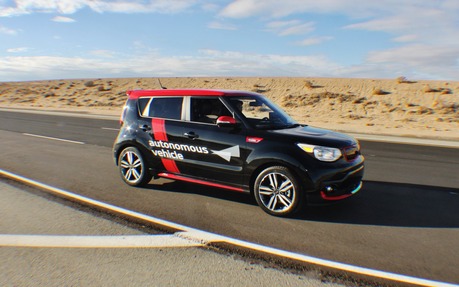Autonomous Kia Soul: Level 4 Achieved, Level 5 Coming Soon
MOJAVE, California — These are exciting times in the quest for the self-driving car. Many believe that autonomous vehicles are not far from becoming a reality, and the truth is that driver support devices are already foreshadowing it. From adaptive cruise control, blind spot detectors or lane change warning, all these systems use technology that is increasingly common in the industry.
During a visit to one of Kia’s competitors a few years ago, one of our hosts mentioned to us that the quantity of cameras in cars would continue to grow in the future, and that’s definitely the case with Kia’s self-driving car. To see for ourselves, we test drove the level 4 autonomous Kia Soul EV. Level 4 means it’s only partially autonomous, but at level 5, this Kia will be totally autonomous.
But make no mistake: “partially autonomous” is still revolutionary when it comes to operating an automobile. We had the chance to see it firsthand in a Soul equipped with this new technology. Right off the bat, our engineer raised his arm and touched the screen of his watch to tell the car to come and get us. My grandfather would have passed out at the mere sight of this driverless Kia.
Once comfortably seated on board, you start the car. From that moment, your hands and feet are free: the car moves all by itself. It respects road signs, provided they’re indicated on the map, since this Soul relies heavily on the navigation system while sensors and cameras do the rest. It also adapts to the density of traffic and even to the inadequacies of certain drivers.
Case in point: during our test drive on the 6.4-mile track at the Hyundai Research Center in Mojave, California, we were surrounded by three Sorentos, and when one of them completely cut us off, our Soul reacted instantly. The emergency braking was equally responsive. But what happens in the event of a health emergency involving the driver is this Soul’s most interesting feature. A camera located in the instrument pod behind the steering wheel examines the driver’s face and, depending on the driver’s facial expressions, the car can send messages. If the driver loses consciousness, the car slows down and activates the four-way flashers. It reduces its speed, comes to a complete stop on the shoulder and sends an urgent message asking for assistance. Once the emergency vehicle arrives, the attendants can help the driver and press a button on the steering wheel to activate an application that ensures that the car follows the ambulance or tow truck to the destination. Note that you can deactivate autonomous mode at any time.
That’s all spectacular—even revolutionary—but there’s still a lot of work to be done. For example, our intelligent Soul braked too abruptly at obligatory stops. What’s more, it stops for three full seconds, which is much longer than your average driver and too long for most of us. This would get you rear-ended in no time.
And we should also note that this Kia has to drive on clearly marked roads. When we asked the Kia engineers what was the solution for Canadian winters, the response was, “We’re working on it!” Furthermore, strict legislation is needed for these vehicles. How will the autonomous car and the traditional car co-exist on our roads? Right now, there are more questions than answers.
Despite all that, the brass at Kia will put its partially autonomous car on the market for 2020, with truly intelligent cars slated for about 2030. Is this realistic? I think so, but not everywhere. The state of Nevada has already given the green light, but the conditions there are ideal for it—and this approval may even be an attempt to attract a new industry to the area.
In conclusion, the Korean manufacturer wasn’t short on self-confidence at CES 2016. In addition to the driverless Soul, the Kia Novo concept car was there. This full-size sedan features futuristic new technology like a three-dimensional holographic display or customized, fingerprint sensing ignition, to say nothing of the gesture control that governs the majority of the instruments. And to complete the picture, there was the new Sportage equipped with known technological additions such as driver support devices.
Kia thus joins the ranks of groundbreaking manufacturers. In addition to the plug-in hybrid and the all-electric car, Kia is confidently diving into the 22nd century. Others will certainly follow, but for now, Kia’s out to the early lead.
